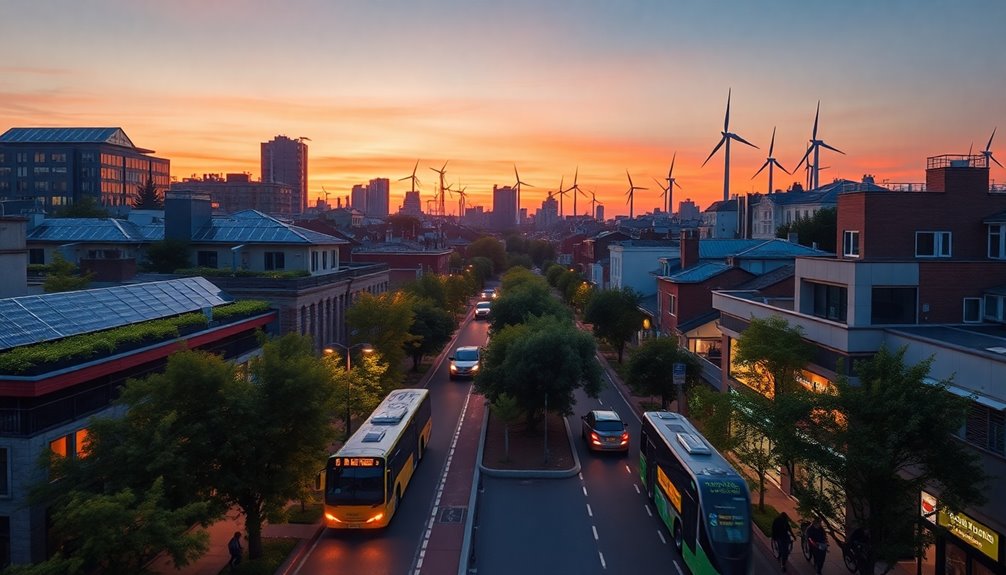Urban decarbonization policies focus on integrated strategies across various sectors. You'll find that urban planning promotes walkability, while circular economy approaches minimize waste. The energy sector is transforming through renewables like solar and wind, alongside smart grids. Transportation innovations encourage electric vehicles and public transport enhancements. Meanwhile, building practices emphasize energy efficiency. Each strategy works together to reduce emissions effectively. There's much more to explore about how these elements fit into the bigger picture.
Key Takeaways
- Integrated urban planning emphasizes compact, mixed-use environments to enhance walkability and reduce emissions while improving quality of life.
- Circular economy strategies promote resource reuse and waste minimization, aligning with sustainable development goals for urban environments.
- Transitioning to renewable energy technologies is essential for urban decarbonization, supported by smart grid infrastructure and energy storage solutions.
- Innovations in transportation, including electric vehicles and improved public transit, are crucial for reducing urban emissions and promoting sustainable mobility.
- Energy-efficient building designs and retrofitting existing structures play a significant role in minimizing energy consumption and achieving urban decarbonization targets.

As cities grapple with the urgent challenge of climate change, urban decarbonization policies play a crucial role in shaping sustainable futures. You need to understand that integrated urban planning is at the heart of these policies, promoting compact, mixed-use environments that prioritize walkability and efficient public transport. This approach not only reduces emissions but also enhances the quality of urban life. Implementing green infrastructure can further support these initiatives by providing essential ecosystem services.
Adopting a systems approach is essential, as it emphasizes the interdependencies within urban systems. By viewing cities holistically, you can identify feedback mechanisms that allow for coordinated and effective solutions. Circular economy strategies also come into play, focusing on minimizing waste and maximizing resource utilization. Implementing closed-loop systems ensures that resources are reused, which aligns with sustainability goals like SDG11 and SDG13.
A systems approach reveals urban interdependencies, fostering effective solutions and promoting circular economy strategies for sustainability.
In the energy sector, you're witnessing a shift toward renewable energy technologies like solar PV and wind turbines. These sources are now becoming competitive with fossil fuels, but energy storage solutions are crucial for stabilizing their integration into urban grids. Smart grid infrastructure enhances the efficiency and reliability of electricity distribution.
By supporting carbon pricing mechanisms, you can incentivize emissions reductions and encourage investments in green energy policies.
Transportation is another critical area where decarbonization strategies shine. Electric vehicle technologies are gaining traction, reducing emissions significantly. Enhancing public transportation systems and advocating for transit-oriented development ensures that urban design revolves around accessibility. Implementing sustainable transportation policies, including walking and cycling, promotes low-carbon mobility, while zero-emission zones restrict fossil fuel-based vehicles.
The building sector also plays a vital role in this transition. Energy-efficient designs minimize consumption, while building energy performance standards regulate energy use in new constructions. Retrofitting existing buildings can significantly reduce emissions.
Frequently Asked Questions
What Are the Main Barriers to Urban Decarbonization?
Urban decarbonization faces several key barriers you'll need to navigate.
First, there's often a lack of political will, making it tough to implement necessary changes. Financial constraints can limit your city's ability to invest in sustainable infrastructure.
Additionally, outdated legacy systems and technological gaps complicate integration.
Lastly, social challenges, like equitable access to benefits and potential displacement, must be addressed to ensure all communities participate in the transition to a greener future.
How Can Citizens Participate in Decarbonization Efforts?
Did you know that communities with active citizen engagement in decarbonization projects can reduce carbon emissions by up to 25%?
You can participate in these efforts by joining local initiatives, attending public forums, and providing feedback on climate policies.
Volunteer for community clean-ups or educational programs to raise awareness.
Collaborating with neighbors and local leaders on sustainable projects not only helps the environment but also strengthens your community bonds.
What Role Does Technology Play in Urban Decarbonization?
Technology plays a crucial role in urban decarbonization. You can leverage smart infrastructure, like energy-efficient buildings and renewable energy sources, to reduce emissions.
Data analytics helps you optimize energy use and transportation systems, while IoT devices monitor urban resources effectively. By engaging with digital platforms, you can promote sustainable practices within your community.
Additionally, innovative financing models support large-scale implementations, making it easier for cities to adopt these essential technologies for a greener future.
How Do Decarbonization Policies Impact Local Economies?
Decarbonization policies can significantly boost local economies by creating green jobs and attracting investments in sustainable technologies.
As you transition to renewable energy sources, you'll likely see reduced energy costs, freeing up resources for further investments.
These initiatives not only enhance energy efficiency but also improve urban competitiveness, making your city a more attractive place for businesses and talent.
Ultimately, embracing decarbonization can lead to a more resilient and prosperous community.
What Metrics Are Used to Measure Decarbonization Progress?
Measuring decarbonization progress is like navigating a complex maze; you need the right metrics to find your way.
You'll look at fuel mix, CO2 emissions intensity, and total CO2 emissions to gauge effectiveness. Additionally, tracking low-carbon investments and decarbonization goals helps you understand where you stand.
Conclusion
In conclusion, urban decarbonization policies are crucial for achieving sustainable cities. Did you know that cities are responsible for about 70% of global carbon emissions? This staggering statistic highlights the urgent need for strategic approaches to reduce these emissions. By implementing effective policies, cities can lead the way in combatting climate change, improving air quality, and enhancing residents' quality of life. It's clear that every action counts in creating a greener, more sustainable future.









